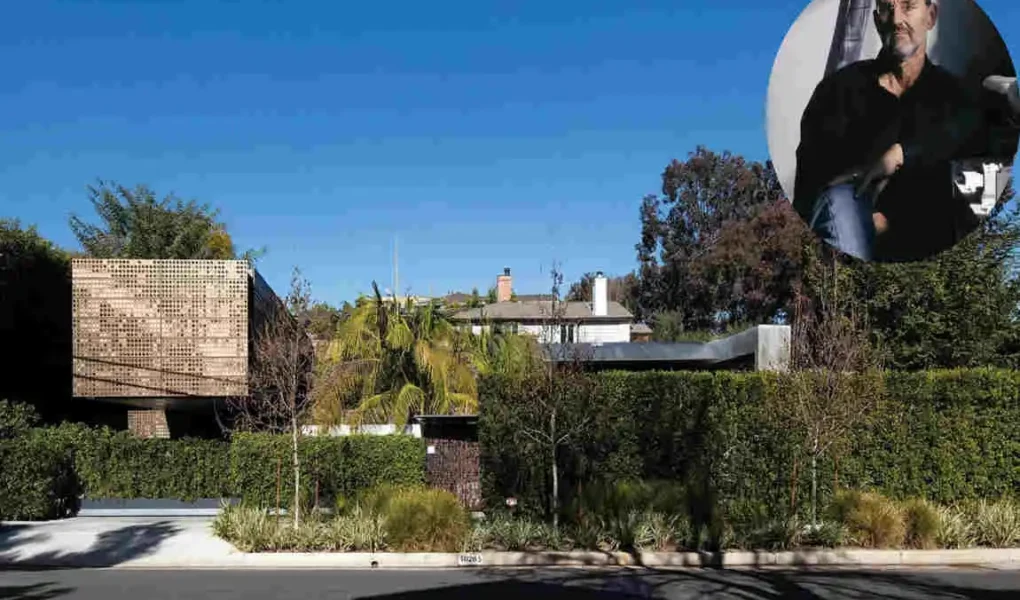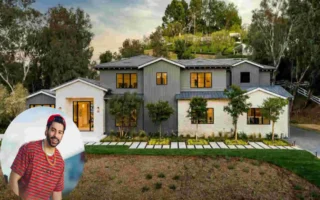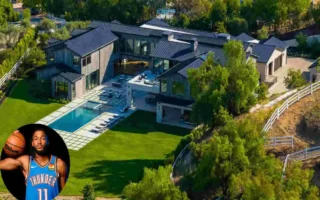Have you ever walked into a space that completely challenged your perception of what a home should be? That’s precisely what happens when you step into the Thom Mayne House. This architectural marvel isn’t just a residence—it’s a bold statement that pushes the boundaries of modern living.
| Category | Details |
|---|---|
| Full Name | Thom Mayne |
| Date of Birth | January 19, 1944 |
| Place of Birth | Waterbury, Connecticut, USA |
| Education | Bachelor of Architecture, University of Southern California (1968) |
| Master of Architecture, Harvard University Graduate School of Design (1978) | |
| Profession | American architect, founding principal of Morphosis Architects |
| Notable Awards | Pritzker Architecture Prize (2005), AIA Gold Medal (2013) |
| Early Life | Grew up in Gary, Indiana; family moved to south of Whittier, California |
| Current Residence | Based in Los Angeles, California |
| Firm Location | Morphosis Architects, Culver City, California and New York City |
| Net Worth | Not explicitly stated in sources, typically estimated in millions given his stature |
| Academic Roles | Trustee and coordinator at Southern California Institute of Architecture (SCI-Arc); held teaching positions at SCI-Arc, Cal Poly Pomona, UCLA, Harvard, Columbia, Yale, University of Pennsylvania, and Bartlett School (London) |
Thom Mayne, the visionary architect behind this groundbreaking design, has created something that makes traditional homes look almost timid by comparison. His house serves as a living laboratory where innovative ideas meet everyday functionality. For architecture enthusiasts and professionals alike, studying the Thom Mayne House offers invaluable insights into the future of residential design.
Who Is Thom Mayne? A Brief Background

When you think of architects who’ve reshaped the landscape of modern design, Thom Mayne stands among the giants. Born in 1944, Mayne has spent decades challenging architectural norms and creating structures that seem to defy conventional wisdom.
His journey to becoming a Pritzker Prize winner in 2005 wasn’t conventional either. Mayne co-founded Morphosis in 1972, an architecture firm that would become synonymous with radical innovation and bold experimentation. The firm’s name itself hints at their philosophy—constantly morphing and evolving architectural forms.
What makes Mayne truly unique is his rebellious spirit. He doesn’t just design buildings; he creates experiences that challenge how we interact with space. His work often features:
- Angular geometries that seem to slice through the air
- Raw materials left exposed to celebrate their natural beauty
- Dynamic spaces that flow and transform as you move through them
- Environmental integration that blurs the line between inside and outside
The Thom Mayne Stunning House represents the culmination of these principles applied to residential architecture. It’s not just where he lives—it’s a three-dimensional manifesto of his design philosophy.
Throughout his career, Mayne has maintained that architecture should provoke thought and emotion. His residential designs, including his own home, reflect a deeply personal approach where theoretical concepts meet practical living needs. This balance between the avant-garde and the functional makes studying the Thom Mayne House essential for understanding contemporary architectural innovation.
Context and Location of the Thom Mayne House
| Aspect | Information |
|---|---|
| Architect | Thom Mayne (Morphosis firm) |
| Location | Cheviot Hills, Los Angeles, California |
| Size | 3,800 square feet (excluding 825 sq ft guest wing) |
| Architecture Design | Highly experiential architecture; five partial levels inside, four terrace heights outside; cantilevered forms; glass facades that slide open merging indoors with outdoors; quasi-wild landscaping around a private “canyon”; sustainable design with no conventional air conditioning, uses cross ventilation, rooftop photovoltaic panels, rainwater capture; metal paneling with iridescent coating; blending modern and midcentury modern DNA; private and understated presence from the street. |
| Special Features | Guest wing with two bedrooms; outdoor shower with tropical foliage; sculptural fireplace video; custom steel craftsmanship; lap pool integrated into design; extensive use of natural light via skylights; strong artistic elements integrated into the home. |
| Worth/Cost | Not publicly disclosed |
| Address | Specific address not disclosed publicly for privacy; located on a 9,570-square-foot corner lot in Cheviot Hills, LA |
| History | Built on site of late author Ray Bradbury’s former home after demolition with community consultation; completed construction in 2017 and landscaping in 2021; first new house designed by Mayne for his family in over 20 years; intended as a private, low-profile family retreat rather than ostentatious mansion |
Nestled in the rugged landscape of California, the Thom Mayne House emerges from its surroundings like a geometric outcropping. The location wasn’t chosen randomly—it represents a deliberate dialogue between architecture and nature.
The site presented both challenges and opportunities. Steep slopes, variable weather patterns, and strict building codes could have limited a less imaginative architect. But Mayne saw these constraints as creative catalysts. He designed the house to embrace the terrain rather than fight against it.
Picture this: instead of bulldozing the land flat, Mayne’s design follows the natural contours. The house appears to grow from the hillside, with different levels responding to the changing elevation. This approach creates unexpected vantage points and surprising spatial relationships throughout the modern home.
The California climate played a crucial role in shaping the design. Large glass panels capture spectacular views while allowing natural light to flood the interiors. But these aren’t just windows—they’re carefully calculated apertures that control heat gain and create cross-ventilation patterns.
The surrounding landscape becomes part of the architectural experience. Native plants blend with designed gardens, creating a seamless transition from wild nature to cultivated space. The Thom Mayne House doesn’t just sit on the land—it participates in the ecosystem around it.
Environmental considerations went beyond mere compliance with regulations. Mayne integrated the house with its setting through:
- Strategic positioning to minimize environmental impact
- Natural materials that weather beautifully over time
- Water management systems that work with local rainfall patterns
- Orientation that maximizes passive solar heating and cooling
Architectural Style and Design Philosophy Behind the Thom Mayne House
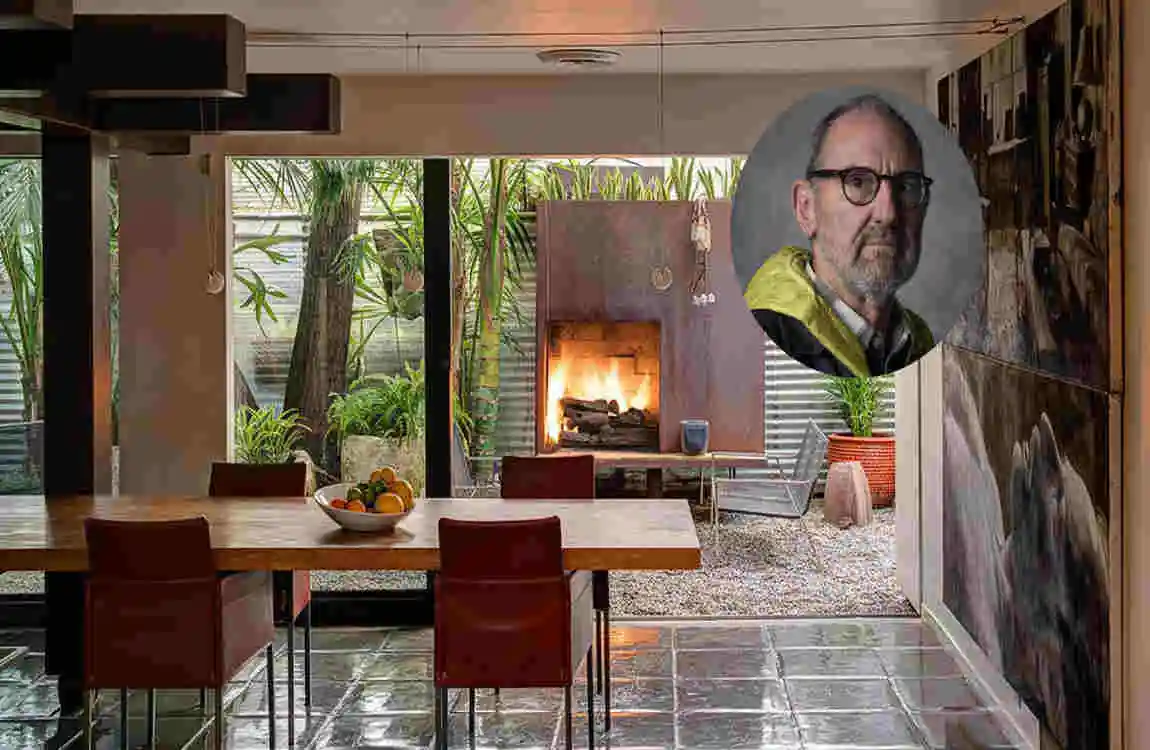
Modernism Meets Deconstructivism
The Thom Mayne House represents a fascinating collision of architectural movements. It takes the clean lines of modernism and twists them into something entirely new. You won’t find the predictable boxes and right angles that define traditional modern homes here.
Instead, Mayne creates spaces that seem to shift and move as you experience them. Walls lean at unexpected angles. Ceilings soar and compress in rhythmic patterns. The overall effect feels less like a static structure and more like a frozen dance.
The Power of Asymmetry
Traditional homes often rely on symmetrical facades and balanced proportions. Mayne throws this rulebook out the window. His house celebrates dynamic imbalance, creating visual tension that keeps your eye moving and your mind engaged.
This asymmetry isn’t random—it’s carefully orchestrated. Each angular shift and unexpected projection serves a purpose, whether it’s framing a view, creating intimate spaces, or directing natural light in specific ways.
Raw Materials as Design Elements
Walk through the Thom Mayne house, and you’ll notice something striking: the materials are unapologetically honest. Concrete shows its texture and imperfections. Steel beams remain exposed, celebrating their structural role. Glass panels seem to float without visible frames.
This material palette creates a powerful aesthetic:
- Concrete provides thermal mass and sculptural presence
- Steel adds industrial elegance and structural clarity
- Glass dissolves boundaries between inside and outside
- Wood brings warmth to balance the harder materials
Spatial Dynamics and Flow
Perhaps the most revolutionary aspect of Mayne’s house design philosophy is his approach to space. Traditional homes divide areas into discrete rooms with clear functions. The Thom Mayne House creates fluid zones that merge and separate as needed.
You might find yourself in a space that serves as a living area, but with a subtle shift in level or a change in ceiling height, it transforms into a more intimate reading nook. These transitions happen organically, guided by the architecture itself rather than conventional walls and doors.
Innovative Features of the Thom Mayne House
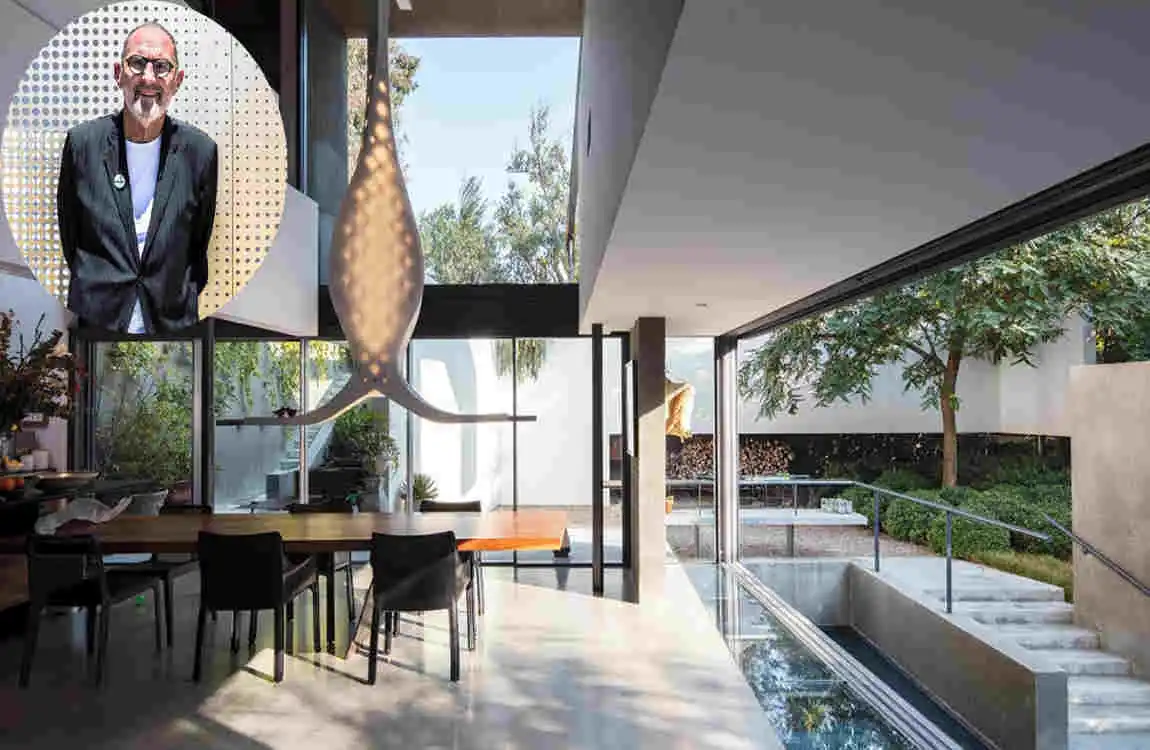
Structural Innovations
The structural system of the Thom Mayne House reads like a masterclass in engineering creativity. Rather than hiding the bones of the building, Mayne celebrates them as design features.
Cantilevered sections jut out dramatically, seeming to defy gravity. These aren’t just for show—they create covered outdoor spaces and help shade interior areas from harsh sunlight. The engineering required to achieve these effects pushes construction techniques to their limits.
The use of steel moment frames allows for incredibly open floor plans. Load-bearing walls become almost extinct, replaced by slender columns that barely interrupt the spatial flow. This structural approach creates flexibility that traditional construction methods can’t match.
Sustainable materials play a crucial role throughout:
Material Sustainable Feature Design Impact
Recycled Steel : Lower carbon footprint, allows dramatic cantilevers
Fly Ash Concrete reduces cement usage, creates unique textures
Reclaimed Wood Preserves forests, adds warmth and character
Low-E Glass Energy efficiency Maintains transparency
Interior Design and Spatial Layout
Step inside, and the revolutionary thinking continues. The interior of the Thom Mayne House challenges every preconception about how homes should function.
Open floor plans take on new meaning here. It’s not just about removing walls—it’s about creating interconnected volumes that flow seamlessly while maintaining distinct identities. A kitchen might spiral into a dining area, which then cascades down to a living space.
Custom furniture designed by Mayne himself integrates with the architecture. Built-in seating emerges from walls. Storage solutions disappear into the structure. Every element serves multiple purposes, maximizing functionality while maintaining the clean aesthetic.
Natural light becomes a design material in its own right. Skylights, clerestory windows, and light wells bring illumination deep into the house. The quality of light changes throughout the day, creating different moods and highlighting various architectural features.
Technology and Sustainability
The Thom Mayne House showcases how cutting-edge technology can enhance rather than dominate residential design. Smart home features are seamlessly integrated, invisible until needed.
Energy efficiency goes beyond basic requirements:
- Solar panels integrated into the roof design
- Geothermal heating and cooling systems
- Advanced insulation using recycled materials
- Smart glass that tints automatically based on sun exposure
Water management receives equal attention. Greywater recycling systems irrigate the landscape. Rainwater collection provides a backup water supply. Native, drought-resistant plants minimize irrigation needs.
The house achieves near net-zero energy consumption without sacrificing comfort or aesthetics. This proves that sustainable design doesn’t mean compromise—it means innovation.
Artistic and Aesthetic Elements
Art isn’t just displayed in the Thom Mayne House—it’s woven into the architecture itself. Sculptural elements serve functional purposes. A dramatic staircase becomes a centerpiece that’s both circulation and installation art.
Color plays a subtle but essential role. The neutral palette of concrete and steel gets punctuated by bold accents. A bright orange door might mark a critical threshold. A blue glass panel could highlight a special view.
Texture adds another layer of richness:
- Board-formed concrete shows wood grain patterns
- Sandblasted steel creates matte surfaces
- Polished concrete floors reflect light
- Rough stone walls provide tactile contrast
Thom Mayne House: Influence on Contemporary Residential Architecture
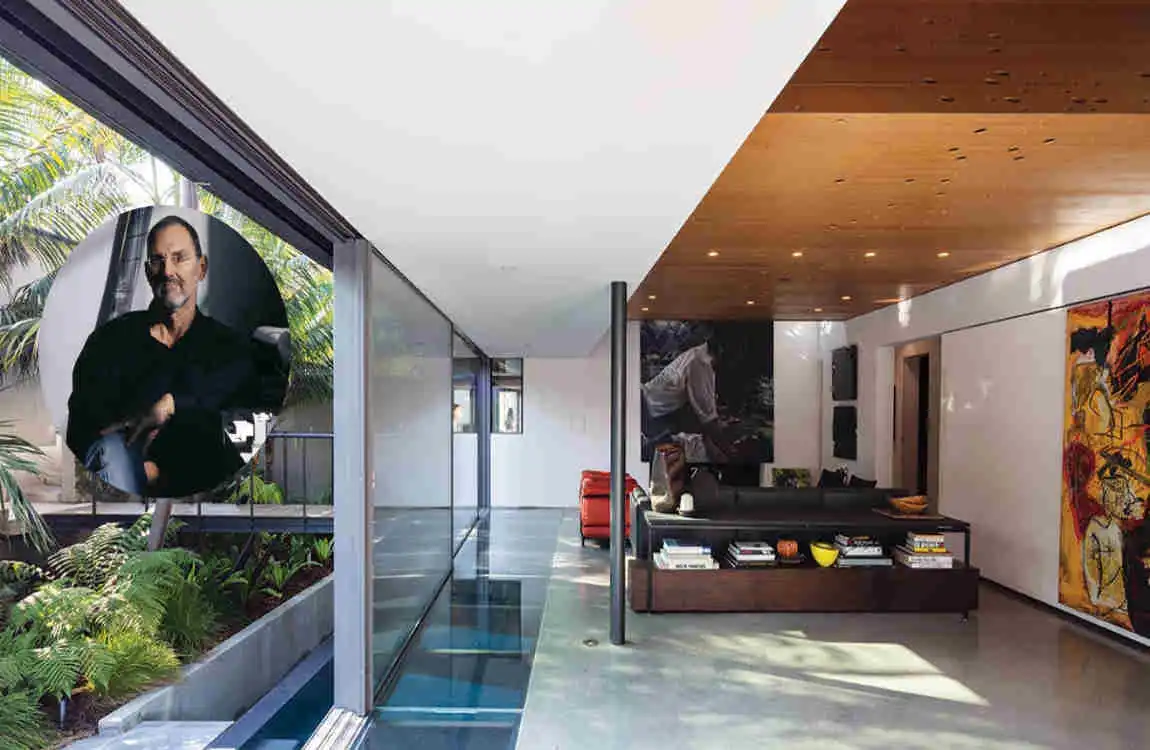
The impact of the Thom Mayne House extends far beyond its physical boundaries. It has become a touchstone for architects worldwide who seek to push residential design into new territories.
Young architects study its bold geometries and unconventional spaces. They learn that homes don’t need to follow predictable patterns. The house demonstrates that challenging conventions can lead to surprisingly livable solutions.
Several key innovations from the Thom Mayne house now appear in contemporary projects worldwide:
- Integrated indoor-outdoor living spaces
- Multifunctional rooms that adapt to changing needs
- Exposed structural elements as design features
- Sustainable technologies are seamlessly incorporated
The house has sparked meaningful conversations about what modern living means. It raises the question of whether we need traditional room divisions. It asks if homes can be both sculptural objects and comfortable shelters.
Architecture schools now use the Thom Mayne House as a case study. Students analyze how it balances artistic vision with practical requirements. They explore how radical design can still create intimate, human-scaled spaces.
Other notable architects have acknowledged Mayne’s influence on their work. They cite his fearless approach to materials and form. They admire how he creates emotional experiences through architecture.
Challenges and Criticisms
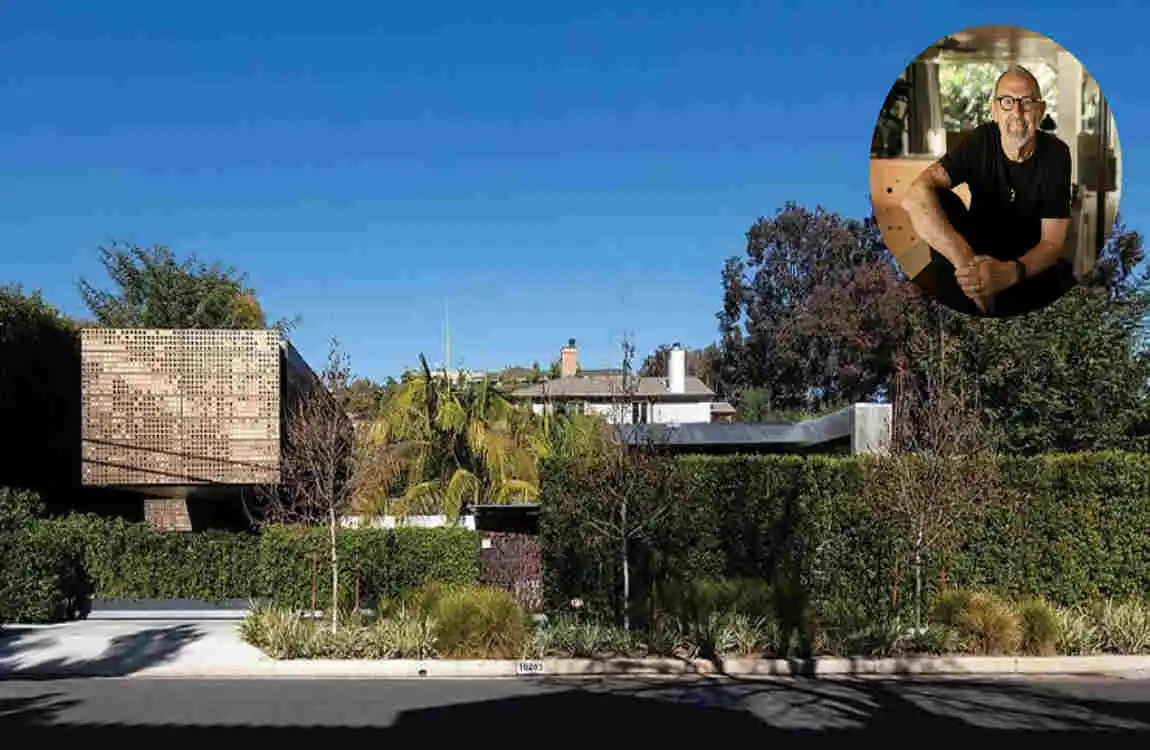
Not everyone embraces the radical vision of the Thom Mayne House. Some critics argue that such experimental designs prioritize form over function. They question whether the average family could comfortably inhabit such unconventional spaces.
Practical challenges certainly exist. Maintaining exposed concrete and steel requires specialized knowledge. Custom windows and unique geometries mean higher repair costs. The open floor plan might lack acoustic privacy for some residents.
Traditional architects sometimes view Mayne’s approach as unnecessarily complex. They argue that good design should be intuitive and straightforward. The angular geometries and industrial materials may feel cold or unwelcoming to those who prefer cozy, traditional homes.
Cost considerations can’t be ignored either. The specialized construction techniques and custom elements make the Thom Mayne House significantly more expensive than conventional buildings. This raises questions about the accessibility of such innovative design approaches.
However, supporters counter that innovation always faces resistance. They point out that many features once considered radical in the Thom Mayne House now appear in mainstream architecture. The house serves as a laboratory where new ideas can be tested and refined.
Visiting and Experiencing the Thom Mayne House

While the Thom Mayne Modern House remains a private residence, its influence can be felt through various channels. Architecture enthusiasts have several options for engaging with Mayne’s residential work.
Virtual tours and detailed photography provide intimate glimpses into the space. These resources allow you to explore the innovative features and understand the spatial relationships. Many architecture websites feature comprehensive galleries documenting the house.
Morphosis occasionally opens select projects for educational tours. While the Thom Mayne House itself isn’t regularly accessible, other residential projects by the firm demonstrate similar principles. These visits offer valuable insights into Mayne’s design process.
For those seeking a deeper understanding, several architecture schools offer study programs that focus on Morphosis projects. These programs often include lectures by firm members and site visits to accessible buildings.
Documentary films about Mayne’s work provide another window into his residential philosophy. These films often feature footage of the Thom Mayne House and interviews explaining the design decisions.
Thom Mayne’s House FAQ
Who is Thom Mayne?
Thom Mayne is a renowned architect and the founder of Morphosis, an architectural firm based in Los Angeles. He is known for his innovative and often unconventional designs, and he won the Pritzker Architecture Prize in 2005 .
Where is Thom Mayne’s house located?
Thom Mayne’s house is located in the Cheviot Hills neighborhood of Los Angeles, California. The house sits on a 9,570-square-foot corner lot .
What is unique about the design of Thom Mayne’s house?
Thom Mayne’s house in Cheviot Hills incorporates several unique design features:
- Tribute to Ray Bradbury: The house includes a decorative metal panel in front with cutout quotes from science fiction writer Ray Bradbury, who previously lived on the same site for 50 years .
- Case Study House Influence: The design was explicitly influenced by the Case Study Houses, known for their modern, California-style architecture with spare lines and indoor-outdoor living .
- Cantilevered Living Room: The living room is cantilevered over the pool and features glass walls that open completely, allowing guests to dive into the pool from the living room .
- Private Canyon: From the street, the house is shielded by hedges and palms, creating a private canyon-like atmosphere .
What was the previous structure on the site of Thom Mayne’s house?
The site where Thom Mayne’s current house stands was previously occupied by the home of science fiction writer Ray Bradbury. Mayne and his wife, Blythe Alison Mayne, purchased the property and demolished Bradbury’s house to build their new home .
How did Thom Mayne honor Ray Bradbury in his new house?
Thom Mayne honored Ray Bradbury by incorporating a decorative metal panel in front of the house with cutout quotes from the author. This was done to pay tribute to Bradbury, who had lived in the same house for 50 years before it was demolished .
What other house did Thom Mayne own before his current residence?
Before moving to his current residence in Cheviot Hills, Thom Mayne and his wife Blythe owned a house in Santa Monica, which was featured in the movie “Heat” directed by Michael Mann. This house was described by Al Pacino’s character in the film as a “dead-tech post-modernistic bullshit house” .
What are the key features of Thom Mayne’s Santa Monica house?
Thom Mayne’s former Santa Monica house, which was available for rent, included the following key features:
- Two bedrooms
- Entry, reception, living, dining, chef’s kitchen, pantry, library, office, and two bathrooms
- Unconventional and abstract design
- Prominent role in the movie “Heat”
The house was described as unconventional and played a significant role in the film, particularly in scenes featuring Al Pacino’s character .
What was Thom Mayne’s approach to designing his new house?
Thom Mayne approached the design of his new house with the intention of creating a simpler notion of form that focuses more on experience and lifestyle rather than the form itself. He wanted the house to be flexible and adaptable to their needs.
Where Does Thom Mayne’s Currently Live?
Thom Mayne currently lives in Los Angeles, California. Specifically, he has a residence in the Cheviot Hills area of Los Angeles, where he built a private house on the site of the former home of writer Ray Bradbury. Mayne has also lived in Santa Monica, a nearby area in Los Angeles, for many years before building the Cheviot Hills house. He is based in Los Angeles, and his architectural firm, Morphosis, has offices there as well as in New York City.
Thom Mayne’s House Photos




